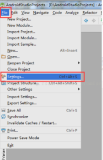第一种:oncreate里启动自定义view
Activity代码:
|
1
2
3
4
5
6
7
8
9
10
11
12
13
14
15
16
17
18
19
20
21
22
23
24
25
26
27
28
29
|
import
android.os.Bundle;
import
android.app.Activity;
import
android.view.Menu;
public
class
MainActivity
extends
Activity
{
/**
* 两种方法:
* 1.直接在layout里找到自定义控件
* 2.oncreate里启动自定义view
*/
@Override
protected
void
onCreate(Bundle savedInstanceState)
{
super
.onCreate(savedInstanceState);
//先new一个自定义view对象
VerticalTextView view =
new
VerticalTextView(
this
);
setContentView(view);
// setContentView(R.layout.activity_main);
}
@Override
public
boolean
onCreateOptionsMenu(Menu menu)
{
getMenuInflater().inflate(R.menu.main, menu);
return
true
;
}
}
|
View类代码:
|
1
2
3
4
5
6
7
8
9
10
11
12
13
14
15
16
17
18
19
20
21
22
23
24
25
26
27
28
29
30
31
32
33
34
35
36
37
|
import
android.content.Context;
import
android.graphics.Bitmap;
import
android.graphics.BitmapFactory;
import
android.graphics.Canvas;
import
android.graphics.Color;
import
android.graphics.Paint;
import
android.view.View;
public
class
VerticalTextView
extends
View
{
//定义一个自定义角度的文本
private
Paint mPaint;
public
VerticalTextView(Context context)
{
super
(context);
init();
}
private
void
init()
{
mPaint =
new
Paint();
mPaint.setColor(Color.BLUE);
mPaint.setTextSize(
50
);
mPaint.setAntiAlias(
true
);
//设置抗锯齿
}
@Override
protected
void
onDraw(Canvas canvas)
{
super
.onDraw(canvas);
Bitmap bitmap = BitmapFactory.decodeResource(getResources(), R.drawable.bg);
canvas.rotate(
75
);
// canvas.rotate(60,bitmap.getWidth()*2 , bitmap.getHeight()*2);
canvas.drawText(
"CanvasHello"
,
0
,
0
, mPaint);
canvas.drawBitmap(bitmap,
0
,
0
, mPaint);
}
}
|
第二种:直接在layout里找到自定义控件(直接新建custom view)
1.新建attrs文件,增加自定义属性:
增加属性内容:
|
1
2
3
4
5
|
<declare-styleable name=
"LabelView"
>
<attr name=
"text"
format=
"string"
/>
<attr name=
"textColor"
format=
"color"
/>
<attr name=
"textSize"
format=
"dimension"
/>
</declare-styleable>
|
或者:
|
1
2
3
4
5
6
7
8
9
|
<declare-styleable name=
"DraggableDot"
>
<attr name=
"radius"
format=
"dimension"
/>
<attr name=
"legend"
format=
"string"
/>
<attr name=
"anr"
>
<
enum
name=
"none"
value=
"0"
/>
<
enum
name=
"thumbnail"
value=
"1"
/>
<
enum
name=
"drop"
value=
"2"
/>
</attr>
</declare-styleable>
|
范例:
|
1
2
3
4
5
6
7
|
<resources>
<declare-styleable name=
"MyView"
>
<attr name=
"mytext"
format=
"string"
/>
<attr name=
"mytextColor"
format=
"color"
/>
<attr name=
"mytextSize"
format=
"dimension"
/>
</declare-styleable>
</resources>
|
2.增加自己的命名空间,将android修改为自己的包名:
|
1
2
|
<RelativeLayout xmlns:android=
"http://schemas.android.com/apk/res/android"
xmlns:MyView=
"http://schemas.android.com/apk/res/com.example.aexh23_paint_canvas"
|
3.在layout中创建自定义view,设置自定义属性(控件包名记得修改):
|
1
2
3
4
5
6
7
8
9
|
<com.example.aexh23_paint_canvas.VerticalTextView
android:id=
"@+id/verticalTextView1"
android:layout_width=
"wrap_content"
android:layout_height=
"wrap_content"
MyView:mytext=
"HelloWorld"
MyView:mytextColor=
"#654321"
MyView:mytextSize=
"35sp"
android:layout_centerHorizontal=
"true"
android:layout_centerVertical=
"true"
/>
|
范例:
|
1
2
3
4
5
6
7
8
9
10
11
12
13
14
15
16
|
<RelativeLayout xmlns:android=
"http://schemas.android.com/apk/res/android"
xmlns:MyView=
"http://schemas.android.com/apk/res/com.example.aexh23_paint_canvas"
xmlns:tools=
"http://schemas.android.com/tools"
android:layout_width=
"match_parent"
android:layout_height=
"match_parent"
tools:context=
".MainActivity"
>
<com.example.aexh23_paint_canvas.VerticalTextView
android:id=
"@+id/verticalTextView1"
android:layout_width=
"wrap_content"
android:layout_height=
"wrap_content"
MyView:mytext=
"HelloWorld"
MyView:mytextColor=
"#654321"
MyView:mytextSize=
"35sp"
android:layout_centerHorizontal=
"true"
android:layout_centerVertical=
"true"
/>
</RelativeLayout>
|
4.在自定义view类中增加方法:
|
1
2
3
4
5
|
setTextColor(a.getColor(R.styleable.LabelView_textColor,
0xFF000000
));
int
textSize = a.getDimensionPixelOffset(R.styleable.LabelView_textSize,
0
);
if
(textSize >
0
) {
setTextSize(textSize);
}
|
范例:
|
1
2
3
4
5
6
7
8
9
10
11
12
13
14
15
16
17
18
19
20
21
22
23
24
25
26
27
28
29
30
31
32
33
34
35
36
37
38
39
40
41
42
43
44
45
46
47
48
49
50
51
52
53
54
55
56
57
58
59
60
61
62
63
64
65
66
67
68
69
70
71
72
73
74
75
76
77
78
79
80
81
82
83
84
85
|
public
class
VerticalTextView
extends
View
{
/**
* 系统范例:LabelView
* 1.新建attrs文件,增加属性:
<declare-styleable name="LabelView">
<attr name="text" format="string" />
<attr name="textColor" format="color" />
<attr name="textSize" format="dimension" />
</declare-styleable>
//////////////////////////////////////////////
<declare-styleable name="DraggableDot">
<attr name="radius" format="dimension" />
<attr name="legend" format="string" />
<attr name="anr">
<enum name="none" value="0" />
<enum name="thumbnail" value="1" />
<enum name="drop" value="2" />
</attr>
</declare-styleable>
////////////////////////////////////////////////
2.增加自己的命名空间,将android修改为自己的包名
<RelativeLayout xmlns:android="http://schemas.android.com/apk/res/android"
xmlns:MyView="http://schemas.android.com/apk/res/com.example.aexh23_paint_canvas"
3.在layout中创建自定义view,增加属性
<com.example.aexh23_paint_canvas.VerticalTextView
android:id="@+id/verticalTextView1"
android:layout_width="wrap_content"
android:layout_height="wrap_content"
MyView:mytext="HelloWorld"
MyView:mytextColor="#654321"
MyView:mytextSize="35sp"
android:layout_centerHorizontal="true"
android:layout_centerVertical="true" />
4.在自定义view类中增加方法
setTextColor(a.getColor(R.styleable.LabelView_textColor, 0xFF000000));
int textSize = a.getDimensionPixelOffset(R.styleable.LabelView_textSize, 0);
if (textSize > 0) {
setTextSize(textSize);
}
*/
private
Paint mPaint;
private
CharSequence s;
private
int
c;
private
int
d;
public
VerticalTextView(Context context, AttributeSet attrs)
{
super
(context, attrs);
TypedArray a = context.obtainStyledAttributes(attrs,
R.styleable.MyView);
s = a.getString(R.styleable.MyView_mytext);
c = a.getColor(R.styleable.MyView_mytextColor,
0xFF000000
);
d = a.getDimensionPixelOffset(R.styleable.MyView_mytextSize,
0
);
init();
a.recycle();
}
//定义画笔
private
void
init()
{
mPaint =
new
Paint();
mPaint.setColor(c );
mPaint.setTextSize(d);
mPaint.setAntiAlias(
true
);
// 设置抗锯齿
}
@Override
protected
void
onDraw(Canvas canvas)
{
super
.onDraw(canvas);
Bitmap bitmap = BitmapFactory.decodeResource(getResources(), R.drawable.bg);
canvas.rotate(
30
);
// canvas.rotate(60,bitmap.getWidth()*2 , bitmap.getHeight()*2);
canvas.drawText(s.toString(),
0
,
0
, mPaint);
canvas.drawBitmap(bitmap,
0
,
0
, mPaint);
}
}
|
本文转自 glblong 51CTO博客,原文链接:http://blog.51cto.com/glblong/1228552,如需转载请自行联系原作者

